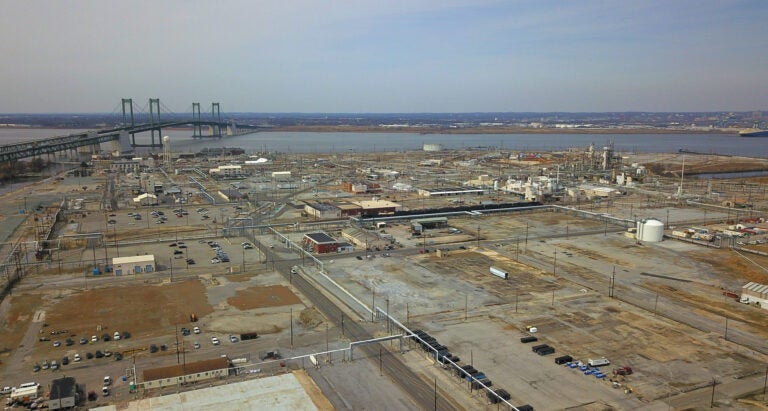Toxic chemicals at Salem County site sharply exceeded N.J. safety limits
The EPA says it’s working with the owner of the former DuPont plant to prevent spread to private water wells.

The Chemours site Chambers Works in Salem County. (Tim Larsen/Office of New Jersey Attorney General)
This story originally appeared on NJ Spotlight.
___
Newly released data on contamination at the Chambers Works site in Salem County shows that groundwater contained three PFAS chemicals at levels that sharply exceeded the health limits recently set by New Jersey regulators.
The data from the U.S. Environmental Protection Agency was based on samples taken on-site between July and December last year at the former DuPont chemical manufacturing complex, which is now owned by Chemours.
The tests showed that PFOA, one of the toxic PFAS family of chemicals, was found at up to 310,000 parts per trillion or more than 22,000 times the upper limit set this year by the Department of Environmental Protection as safe for human consumption in drinking water.
PFNA, another type of PFAS chemical, was found as high as 120,000 parts per trillion, or more than 9,000 times what the DEP set as a maximum contaminant level in 2018. A third chemical, PFOS, was found at much lower levels — up to 100 parts per trillion — but that was still more than seven times higher than the limit New Jersey water suppliers are now required to achieve in public drinking water supplies.
The data also included samples of 13 other types of PFAS chemicals that are not regulated by New Jersey or the federal government. They include GenX, one of a new generation of chemicals designed to replace older PFAS because of the growing health concerns, but which some scientists believe are just as toxic.
The data was obtained by NJ Spotlight in response to a request for New Jersey specifics on EPA’s “PFAS Action Plan,” a program designed to monitor and remediate the toxic chemicals nationwide.
PFAS, formally known as per- and polyfluoroalkyl chemicals, were once used in consumer products like nonstick cookware and flame retardant fabrics, and have been linked to illnesses including some cancers, developmental problems in children, ulcerative colitis, and immune-system conditions.
‘Forever chemicals’
They have caused growing concern among health professionals and some state governments because the chemicals don’t break down in the environment, and so can be found at high concentrations in soil and groundwater long after their manufacture or use has ended, earning them the label “forever chemicals.” They have been found at higher levels and in more places in New Jersey than in many other states because of its long industrial history, according to state and federal studies over the last decade.
Despite the health concerns and the EPA program, the chemicals remain unregulated nationally, leaving states like New Jersey to set their own limits.
EPA also released data on testing at a Gloucester County site where Solvay Specialty Chemicals used the chemicals until 2010. The data, based on sampling of 37 wells between 2013 and 2017, also showed some at levels far above the health limits set by New Jersey.
One of the Solvay wells found PFNA more than 37,000 times higher than the DEP limit, while PFOA was found at more than 1,600 times above the level for that chemical.
High PFAS contamination at the Solvay site in West Deptford has been known for years, and has prompted a federally funded investigation into any links between PFAS and illness, due to be conducted this fall by the Rutgers School of Public Health.
Earlier study of Paulsboro residents
Dr. Robert Laumbach, Associate Professor of Environmental and Occupational Health at the Rutgers school, said the Solvay data was “extremely high.” An earlier study by Laumbach and other researchers published in 2018 found that PFNA levels in blood taken from residents of nearby Paulsboro was 285% higher than the national average, and was linked to elevated cholesterol.
EPA said a carbon filtration system was installed at the Solvay site to reduce PFAS concentration in on-site groundwater prior to discharge to the Delaware River and to control offsite PFAS groundwater migration.
Solvay did not respond to requests for comment.
At the Chemours site in Salem County, where DuPont made chemicals starting in the late 19th century, EPA said measures have been taken by the company and government officials to prevent or minimize the migration of chemicals into water wells used by residents in nearby towns including Carney’s Point, Pennsville, and Pedricktown.
“Contaminated groundwater is currently contained onsite at Chemours through an extensive sheet pile barrier and an interceptor well system that pumps groundwater and sends it to an onsite wastewater treatment plant before it is pumped into the Delaware River,” EPA said in a statement. In one building on-site, officials have installed a carbon filtration system to reduce the emission of PFAS chemicals through the air, the agency said.
Chemours, which took over the site from DuPont in 2015, said it has a program to monitor and remediate the chemicals in private water wells nearby.
Any homeowner whose well water exceeds the state health limits will be offered a filtration system, or connection to a public water system at no cost to the resident, the company said. “We have and continue to implement remediation programs and invest in emissions control technologies at the site,” it said.
Bottled water ‘in perpetuity’
Another option for homeowners with PFAS-contaminated water is to receive bottled water “in perpetuity,” EPA said.
The agency said it is “heavily involved” in the off-site monitoring program; holds monthly calls with the company and New Jersey DEP to discuss well-sampling results, and is working to increase public transparency about the well-testing program.
DEP did not respond to a request for comment on the EPA data but said in March last year that 168 of 341 private water wells tested within five miles of the plant exceeded the health limits for PFNA, PFOA and PFOS. The data was part of a DEP “directive” for cleaning up PFAS contamination filed against five chemical companies including DuPont and Chemours. The DEP later said it would take “years” to resolve the directive.
Some local residents blame the plant for their illnesses but say they are unlikely to be able to prove a link.
Tracy Carluccio, deputy director of the environmental group Delaware Riverkeeper Network, and a longtime campaigner for PFAS regulation, said she had been unaware that some residents were being offered a permanent supply of bottled water but questioned whether such supplies would be enough to meet all household needs.
Carluccio said she didn’t know of any study on whether the health of residents near Chambers Works has been affected by PFAS contamination, but urged state and local officials to conduct such an investigation.
“These communities are closest to the facilities long known to be major sources of PFAS contamination and people deserve to know if they and their families’ health has been negatively affected,” she said.
WHYY is your source for fact-based, in-depth journalism and information. As a nonprofit organization, we rely on financial support from readers like you. Please give today.





